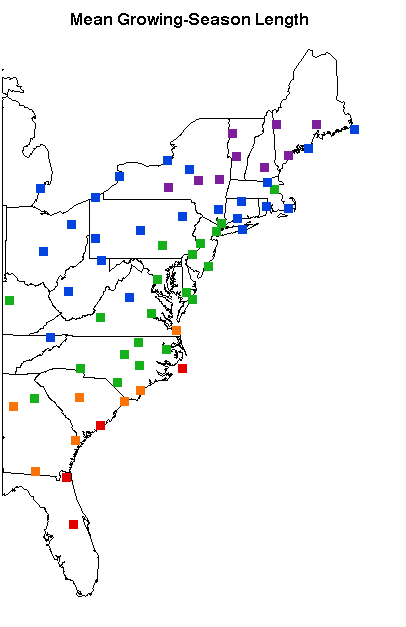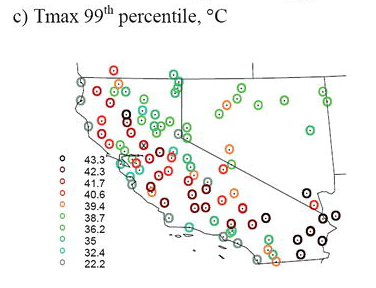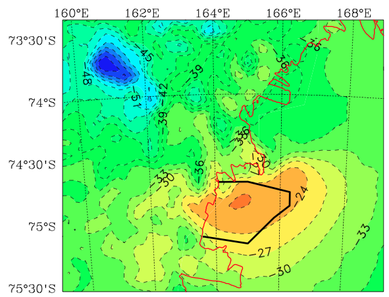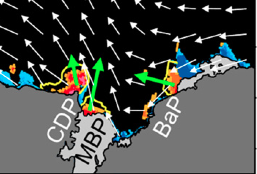|
Two recent events here in New York City have been clear reminders of the impact of the city's coastal location. An exceptionally warm December (warmer even than the average November) helped delay the first below-freezing temperature until January 4, for a growing season that clocked in at 271 days. Then the abbreviated winter did all it could to make up for lost time, producing a storm that dropped 24"-36" of snow from West Virginia through Long Island, in one moisture-laden shot bringing the region's total snowfall in line with much colder and typically snowier areas. These got me thinking about coastal climates — in particular, how they are milder than continental climates (e.g. continental interiors like Mongolia or Kansas) in some respects and places, but more-extreme in others. Thermal stabilization comes first to mind, because it's so intuitive and ubiquitously observable: water has four times the specific heat and about 800 times the density of air, so 3200 times the heat capacity. If 'everything in moderation' is a good mantra for life, then water is the greatest life-enabler of all. Without it transporting massive amounts of heat from the tropics to the poles, the latter would be completely inhospitable; the striking warmth of the North Atlantic relative to continental regions at the same latitude bears that out. The same map also indicates regions where the ocean has a cooling effect, due to upwelling of cold deep waters or to equatorward transport of cold waters via surface currents like the Labrador. Also of note is that, following Newton's Law of Cooling, water's moderating effect gets stronger as the air temperature gets more extreme. This can play out directly, with sea/lake breezes, or indirectly, such as when cold air triggers lake-effect clouds (and snow) that keep temperatures from dropping extremely low in the onshore areas. In the case of the freeze-less November/December in NYC, an analysis of mean growing-season length shows that the signature of the coast is very strong, lengthening the season by something like 25 or 50 days relative to inland locations (see lefthand figure below), a significant effect even with some uncertainty for elevation- and urban-based differences. Water is a very abundant source of water — this truism means that oceans tend to be cloudier than land, and this contrast is particularly striking in subtropical areas where cool, moist marine-influenced air and warm, dry continental air abut each other, such as in southwestern Africa, western South America, and southwestern North America. The difference leads to stratification, copious layers of low stratus clouds, and, very often, to seasonally imperturbable levels of stability that limit the mixture of the two air masses. For southwestern North America the effect of this stability is clearly manifest in the summertime mean-temperature field shown in the other two figures above. [I was a bit incredulous at the coolness of the coast even for extreme events during boreal summer, but independent data searching backs it up.] Any lapse in protection by the cool water (e.g. when a high-pressure system results in easterly winds and prevents the cold moist air from seeping inland) is immediately felt. Warm water, on the other hand, is a powerful destabilizing force, as when moist Gulf of Mexico air comes rolling across the Plains and interacts with air descending from the heights of the Rockies. Again, the Persian Gulf and Red Sea emerge as prominent unique areas. Several weeks ago I had the chance to speak with Jeremy Pal, who recently wrote about this, and asked him about the dynamics of the coastal environments surrounding them; he remarked that their shallow connections to the Indian Ocean (through the Straits of Hormuz and Mandeb) combined with their high surface-area-to-volume ratios allow them to heat up dramatically in the summer, so much so that the sea breezes they generate could hardly be considered refreshing — not when the air above them has a dewpoint close to the sea-surface temperature of 33 C (thereby supporting wet-bulb temperatures of the same magnitude). One less-appreciated benefit expanses of water provide comes from what they are not — namely, with the exception of ship traffic, they are not places that people have yet figured out how to pollute from. As a result, cities like Seattle have some of the cleanest air in the U.S., their only imported pollutants being those that are long-lived-enough to make it across the Pacific from Asia. A last curiosity on this tour are the ice-formation zones off of Antarctica and in certain areas of the Arctic, where the offshore, downslope katabatic wind from the continental interior is so strong as to continually blow newly formed ice out to sea and leave coastal areas of open water called polynyas. These zones are biologically rich from phytoplankton all the way up the food chain to seals and penguins, despite being from a human perspective incredibly harsh environments.
Needless to say, no major cities are located near any of them. In the tropics and the mid-latitudes, where the weather is not normally so vicious, coastal environments above the tidal zone are typically more moderate than nearby inland areas when looking at averages, which is one reason (along with trade) why coasts are much more densely populated than continental interiors — but an alarming number of hazards do come from the ocean: tsunamis, tropical cyclones, severe thunderstorms, indeed storms of all types fed by its moisture supply (as in the snowstorm mentioned to lead off this post), not to mention the natural swings in ocean sea-surface temperature that reverberate around the globe in the form of various climate oscillations. Which may be why, in terms of conduciveness for migrations and other landmark events in human history, maritime archaeologists have posited that coasts are much more unstable and unfavorable than has previously been assumed. Perhaps instead of eliminating the speculative mythical creatures that inhabited the oceans on old maps, we should replace them with the dangers that we know are actually out there.
0 Comments
|
Archives
September 2023
Categories |





 RSS Feed
RSS Feed